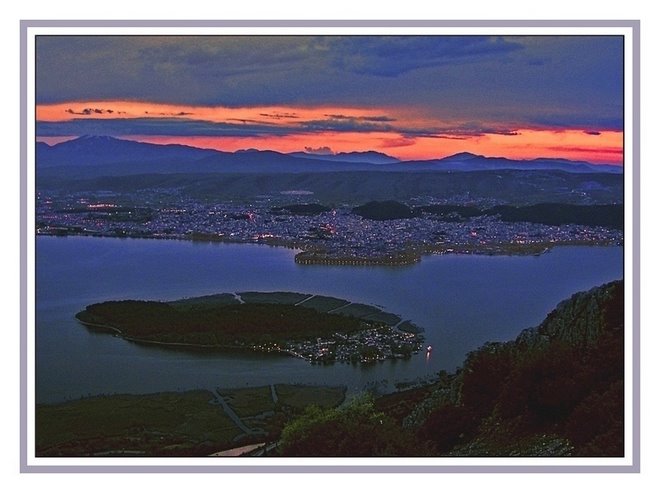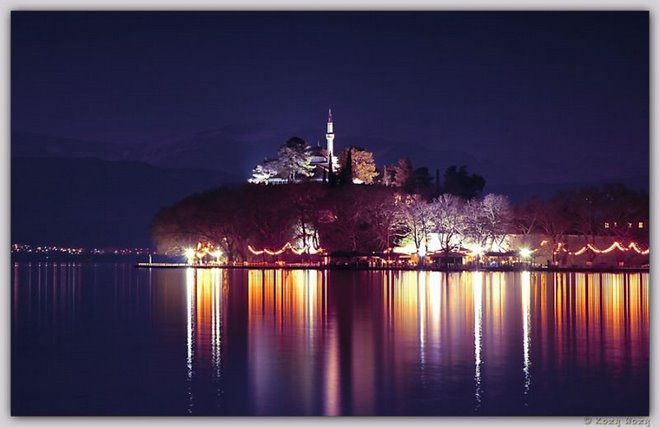Κυριακή 7 Οκτωβρίου 2007
Σάββατο 28 Ιουλίου 2007
Σάββατο 14 Ιουλίου 2007
Δευτέρα 25 Ιουνίου 2007
Κυριακή 24 Ιουνίου 2007
ΙΩΑΝΝΙΝΑ
IOANNINA
IOANNINA or YIANNINA (44,829 inhab.) is the capital of the prefecture of of Ioannina, the administrative capital Epirus. The busy and friendly town lies at 475m in the midst of a plain divided between pasture and the cultivation of cereals and tobacco. Local industries include the manufacture of filigree silver jewellery. To the E and SE of the town rise the highest peaks of the Pindus, Mt Peristeri . The summers are hot and the winters are long and cold. The Lake of Ioannina, or Limni Pambotis, is fed by torrents from the precipices of Mitsikeli. It is l0-ll km long, averages 3km across, and ranges in depth from 9-20m, with shallow reedy shores. The lake has an island (NISI) on which are numerous monasteries situated amid trees and flowers. One of these is the Monastery of the Prodhromos(St. John the Baptist) to the E of the little island village. Its most ancient parts (13C) are the katholikon and the E aisle. It was restored in the 16C, the 18C frescoes in the 19C. In the 16C Monastery of Pantaleimon, near by, Ali Pasha was killed on 17 January 1822; the bullet marks on the floor witness to his assassination. The whole island is registered by the Greek Archeological Service as a place of archeological significance.
HISTORY COMES ALIVE IN IOANNINA
loannina is first documented in 1020 and may have taken name and site from a monastery of St John the Baptist. loannina dates its importance, however, from the influx of refugees in 1205 from Constantinople and the Pelloponese and its consequent fortification by Michael I Angelos. An archbishopric was established here between 1284 and 1307. In 1345 Ioannina was captured by the Serb Stefan Dusan, proclaimed in the following year Emperor of Serbia and Greece. In 1431 it surrendered to the army of the Sultan Murad II. In 1618, after an abortive rising led by Dionysos 'Skylosophos' the fanatical Bp of Trikkala, the Christians were expelled from the citadel and their churches destroyed.
Its zenith was reached under Ali Pasha, (born in 1741 at the Albanian village of Tepeleni), a brilliant, resourceful and vindictive adventurer who alternately fought and served the Sultan of Turkey. Having assisted the Turks in their war of 1787 against Austria, he was made Pasha of Trikkala in 1788, in which year he seized Ioannina, then a town of 35,000 inhabitants, and made it his headquarters. In 1797 he allied himself with Napoleon, but the next year he took Preveza from the French. In 1803 he subdued the Suliots. After 1807 his dependence on the Porte was merely nominal. Byron visited Ioannina in 1809, while Col. W. M. Leake, the great topographer of Greece, was British resident, and Henry Holland was Ali Pasha's doctor. In 1817 Ali entered into an alliance with the British, who gave him Parga. At length the Sultan decided to eliminate this daring rebel. He was captured at loannina after a siege and executed there in 1822. Two years before his death, besieged by Ismail Pasha, he had set fire to the town. The Congress of Berlin (1878) assigned Epirus to Greece but it remained in Turkish hands for over 35 more years. On 21 February 1913, the Greek army liberated Ioannina.
COME FOR A WALK AROUND THE CITY
Yes! Streets like these still exist in Greece. Go for a walk in Ioannina
The social life of Ioannina centres on Odhos Yeoryiou tou Protou which connects PLATEIA PIRROU, a beautiful belvedere laid out in front of the Municipal Offices (View of Mitsikeli), and the KENTRIKI PLATEIA with its clock tower (To Roloi) farther down the hill. Commanding the central square is the Merarkhia (army HQ) in front of which the Colours are ceremonially lowered each evening. Behind, the museum and gardens occupy the levelled upper esplanade of the astro, which once sheltered the Christian quarter of Litharitsa, its walls were demolished by Ali Pasha and the material sed to build his palace and outer fortifications of the town. The N part of the castle has been restored as a cafe-restaurant.
In Ioannina you can still walk on cobblestone streets, where Oriental designs meet the Neo-clasical architecture, you can turn a corner and find yourself transfered from a typical 20th centrury commercial centre to a Middle Eastern bazzar. It is here that even today Oriental and Greek culture are still interlinked. If you want to know more about Ioannina (or Yiannena as I prefer to call it) come with me for a walk down memory lane -still under construction)
Typical traditional house in Ioannina (left) and a street inside the Castle.
St George's Gate in the Castle of Ioannina, the Alsan Pasa Mosque in the Castle. BY http://www.arafura.net.au/greeksnt/
IOANNINA or YIANNINA (44,829 inhab.) is the capital of the prefecture of of Ioannina, the administrative capital Epirus. The busy and friendly town lies at 475m in the midst of a plain divided between pasture and the cultivation of cereals and tobacco. Local industries include the manufacture of filigree silver jewellery. To the E and SE of the town rise the highest peaks of the Pindus, Mt Peristeri . The summers are hot and the winters are long and cold. The Lake of Ioannina, or Limni Pambotis, is fed by torrents from the precipices of Mitsikeli. It is l0-ll km long, averages 3km across, and ranges in depth from 9-20m, with shallow reedy shores. The lake has an island (NISI) on which are numerous monasteries situated amid trees and flowers. One of these is the Monastery of the Prodhromos(St. John the Baptist) to the E of the little island village. Its most ancient parts (13C) are the katholikon and the E aisle. It was restored in the 16C, the 18C frescoes in the 19C. In the 16C Monastery of Pantaleimon, near by, Ali Pasha was killed on 17 January 1822; the bullet marks on the floor witness to his assassination. The whole island is registered by the Greek Archeological Service as a place of archeological significance.
HISTORY COMES ALIVE IN IOANNINA
loannina is first documented in 1020 and may have taken name and site from a monastery of St John the Baptist. loannina dates its importance, however, from the influx of refugees in 1205 from Constantinople and the Pelloponese and its consequent fortification by Michael I Angelos. An archbishopric was established here between 1284 and 1307. In 1345 Ioannina was captured by the Serb Stefan Dusan, proclaimed in the following year Emperor of Serbia and Greece. In 1431 it surrendered to the army of the Sultan Murad II. In 1618, after an abortive rising led by Dionysos 'Skylosophos' the fanatical Bp of Trikkala, the Christians were expelled from the citadel and their churches destroyed.
Its zenith was reached under Ali Pasha, (born in 1741 at the Albanian village of Tepeleni), a brilliant, resourceful and vindictive adventurer who alternately fought and served the Sultan of Turkey. Having assisted the Turks in their war of 1787 against Austria, he was made Pasha of Trikkala in 1788, in which year he seized Ioannina, then a town of 35,000 inhabitants, and made it his headquarters. In 1797 he allied himself with Napoleon, but the next year he took Preveza from the French. In 1803 he subdued the Suliots. After 1807 his dependence on the Porte was merely nominal. Byron visited Ioannina in 1809, while Col. W. M. Leake, the great topographer of Greece, was British resident, and Henry Holland was Ali Pasha's doctor. In 1817 Ali entered into an alliance with the British, who gave him Parga. At length the Sultan decided to eliminate this daring rebel. He was captured at loannina after a siege and executed there in 1822. Two years before his death, besieged by Ismail Pasha, he had set fire to the town. The Congress of Berlin (1878) assigned Epirus to Greece but it remained in Turkish hands for over 35 more years. On 21 February 1913, the Greek army liberated Ioannina.
COME FOR A WALK AROUND THE CITY
Yes! Streets like these still exist in Greece. Go for a walk in Ioannina
The social life of Ioannina centres on Odhos Yeoryiou tou Protou which connects PLATEIA PIRROU, a beautiful belvedere laid out in front of the Municipal Offices (View of Mitsikeli), and the KENTRIKI PLATEIA with its clock tower (To Roloi) farther down the hill. Commanding the central square is the Merarkhia (army HQ) in front of which the Colours are ceremonially lowered each evening. Behind, the museum and gardens occupy the levelled upper esplanade of the astro, which once sheltered the Christian quarter of Litharitsa, its walls were demolished by Ali Pasha and the material sed to build his palace and outer fortifications of the town. The N part of the castle has been restored as a cafe-restaurant.
In Ioannina you can still walk on cobblestone streets, where Oriental designs meet the Neo-clasical architecture, you can turn a corner and find yourself transfered from a typical 20th centrury commercial centre to a Middle Eastern bazzar. It is here that even today Oriental and Greek culture are still interlinked. If you want to know more about Ioannina (or Yiannena as I prefer to call it) come with me for a walk down memory lane -still under construction)
Typical traditional house in Ioannina (left) and a street inside the Castle.
St George's Gate in the Castle of Ioannina, the Alsan Pasa Mosque in the Castle. BY http://www.arafura.net.au/greeksnt/
Posted by
ΞΥΠΝΑΤΕ ΡΑΓΙΑΔΕΣ
at
12:52 π.μ.
0
comments
![]()
Σάββατο 23 Ιουνίου 2007
this is greece

Archaeological sites - Monuments
Greece is full of archaeological sites and monuments of distinctive prestige and charm, on which all known periods of its long-standing history have left their mark. Visitors have the opportunity to make a unique “journey” through the rare “mosaic” of historic and cultural memory which has left an indelible mark on every region of the country and effortlessly highlights the manifold manifestations of Greek culture to date.According to the UNESCO catalogue, the following archaeological sites and cultural areas in Greece have been characterised as Monuments of Cultural Heritage: 1. Monastery complex of Aghio Oros (Mount Athos)2. The Acropolis of Athens3. Vassae: The Temple of Epicurean Apollo4. Vergina - Aegae5. Delphi (archaeological site) 6. Delos (archaeological site) 7. Epidaurus (archaeological site) 8. Early Christian and Byzantine Thessalonica 9. Monastery complex of Meteora10. Mystras (Medieval City) 11.The Monasteries of Daphni (Attica), Ossios Lucas (Central Greece) and Nea Moni (New Monastery) of Chios12. The archaeological sites of Mycenae and Tiryns 13. Olympia (archaeological site) 14. Patmos: Monastery of Aghios Ioannis Theologos and the Cave of the Apocalypse 15. Medieval city of Rhodes16. Samos: Pythagoreio and Heraion
Greece is full of archaeological sites and monuments of distinctive prestige and charm, on which all known periods of its long-standing history have left their mark. Visitors have the opportunity to make a unique “journey” through the rare “mosaic” of historic and cultural memory which has left an indelible mark on every region of the country and effortlessly highlights the manifold manifestations of Greek culture to date.According to the UNESCO catalogue, the following archaeological sites and cultural areas in Greece have been characterised as Monuments of Cultural Heritage: 1. Monastery complex of Aghio Oros (Mount Athos)2. The Acropolis of Athens3. Vassae: The Temple of Epicurean Apollo4. Vergina - Aegae5. Delphi (archaeological site) 6. Delos (archaeological site) 7. Epidaurus (archaeological site) 8. Early Christian and Byzantine Thessalonica 9. Monastery complex of Meteora10. Mystras (Medieval City) 11.The Monasteries of Daphni (Attica), Ossios Lucas (Central Greece) and Nea Moni (New Monastery) of Chios12. The archaeological sites of Mycenae and Tiryns 13. Olympia (archaeological site) 14. Patmos: Monastery of Aghios Ioannis Theologos and the Cave of the Apocalypse 15. Medieval city of Rhodes16. Samos: Pythagoreio and Heraion
Posted by
ΞΥΠΝΑΤΕ ΡΑΓΙΑΔΕΣ
at
1:31 π.μ.
0
comments
![]()
Εγγραφή σε:
Σχόλια (Atom)
ΙΩΑΝΝΙΝΑ
ΙΣΤΟΡΙΑ
Κτισμένη στις όχθες της λίμνης Παμβώτιδας, η πόλη των Ιωαννίνων, και πρωτεύουσα της Ηπείρου, είναι μια γραφική πόλη, που συμπλέει με τον πολιτισμό και συνδυάζει μια μακραίωνη ιστορία αλλά και μια κοινωνική, πολιτιστική και οικονομική δραστηριότητα και άνθηση. Αποτελεί πόλο έλξης και σημείο αναφοράς πολλών επισκεπτών.Όχι τυχαία, φέρει την προσωνυμία «Πόλη των Γραμμάτων και των Τεχνών», αφού ανέδειξε μεγάλες μορφές και στα γράμματα και στις τέχνες, με πανελλήνια, και όχι μόνο, εμβέλεια. Η συμβολή τους, δε, στην αναγέννηση της χώρας μας ήταν τεράστια. Διεύρυναν τους πνευματικούς και πολιτιστικούς ορίζοντες, επέδρασαν καταλυτικά στη διαμόρφωση ιδεών και τάσεων και συντέλεσαν στην ανάπτυξη και εδραίωση του ελληνικού αλλά και πολλές φορές του ευρωπαϊκού πολιτισμού. Τα παραδοσιακά κτίσματα, τα μουσεία, το Κάστρο, το υπαίθριο θέατρο Φρόντζου, μέσα στο αισθητικό δάσος της πόλης και ένας μεγάλος αριθμός σημείων της πόλης, με έντονη ιστορική και πολιτιστική αξία αποτελούν εξαίρετα δείγματα της ηπειρωτικής αρχιτεκτονικής. Το νησάκι της λίμνης Παμβώτιδας, που μέχρι και σήμερα κατοικείται, φαινόμενο σπάνιο παγκοσμίως, είναι ολόκληρο ένα αξιοθέατο με τις εκκλησίες του και ό,τι απέμεινε από το σεράι του Αλή Πασά. Το Πανεπιστήμιο, από τα καλύτερα της Ευρώπης, τα Νοσοκομεία, το ναυταθλητικό κέντρο και μια πληθώρα άλλων κτηρίων που φιλοξενούν αθλητικές και πολιτιστικές εκδηλώσεις όλο το χρόνο μαρτυρούν την εξέλιξη της πόλης στις απαιτήσεις της σύγχρονης κοινωνίας αλλά και την προσπάθειά της να καταστεί κοιτίδα ανάπτυξης και ζωντάνιας, συγκεράζοντας το παλαιό με το νέο, το παραδοσιακό με το σύγχρονο.














